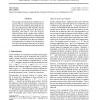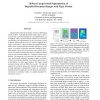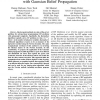613 search results - page 76 / 123 » Learning the Structure of Linear Latent Variable Models |
ICML
2004
IEEE
14 years 9 months ago
2004
IEEE
The assumptions behind linear classifiers for categorical data are examined and reformulated in the context of the multinomial manifold, the simplex of multinomial models furnishe...
CVPR
2009
IEEE
14 years 2 days ago
2009
IEEE
Segmentation of document images remains a challenging vision problem. Although document images have a structured layout, capturing enough of it for segmentation can be difficult....
CORR
2008
Springer
13 years 9 months ago
2008
Springer
Abstract--Interior-point methods are state-of-the-art algorithms for solving linear programming (LP) problems with polynomial complexity. Specifically, the Karmarkar algorithm typi...
CIDM
2009
IEEE
14 years 3 months ago
2009
IEEE
Abstract— A Bayes net has qualitative and quantitative aspects: The qualitative aspect is its graphical structure that corresponds to correlations among the variables in the Baye...
EMNLP
2007
13 years 10 months ago
2007
In Sequential Viterbi Models, such as HMMs, MEMMs, and Linear Chain CRFs, the type of patterns over output sequences that can be learned by the model depend directly on the model�...



